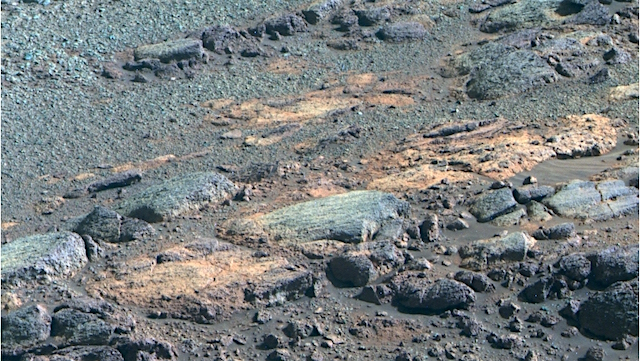 May 4, 2018: Opportunity Studies Mystery Rock, Mission Officials Seek 2019 Extension: Opportunity spent April further exploring the area about halfway down Perseverance Valley, checking out unusual, vesicular or pitted rocks the likes of which she has never seen, while Mars Exploration Rover (MER) officials prepared the mission’s bid to keep the robot field geologist roving through 2019.
May 4, 2018: Opportunity Studies Mystery Rock, Mission Officials Seek 2019 Extension: Opportunity spent April further exploring the area about halfway down Perseverance Valley, checking out unusual, vesicular or pitted rocks the likes of which she has never seen, while Mars Exploration Rover (MER) officials prepared the mission’s bid to keep the robot field geologist roving through 2019.
From Endeavour Crater’s west rim, the valley extends downslope, at about a 15-degree angle, for about 200 meters (about 219 yards) ending at the crater interior. Opportunity drove into the valley, which is within the Cape Byron segment, last July to study it and search for signs of anything in the morphology or shape of this place that can reveal what created it billions of years ago.
Although scientists exploring Mars never really know what to expect, as Opportunity hunkered down over one of the charcoal gray vesicular rocks at a site called San Juan Pueblo, they certainly didn’t expect what they found. At least most of them didn’t. And they’re not exactly sure what is means.
“Yes, this is new,” said MER Project Scientist Matt Golombek, of the Jet Propulsion Laboratory (JPL), home to all NASA’s Mars rovers. “It’s a very interesting rock,very unusual. We haven’t seen anything like this before.”
The vesicular rock outcrop that Opportunity looked at up close – and which the scientists thought could be a volcanic basalt rock – turned out to not be a volcanic basaltic rock. And they’re not exactly sure what it is. Hypotheses are being debated, new data is coming in, and analyses are ongoing. Just like Perseverance, the only geologic formation of its kind in the rim segments of Endeavour, this rock is a mystery.
This valley drew the scientists at first sight. In orbital images, Perseverance looks like a river system on Earth, complete with branches leading in different directions. As appealing as water on Mars is though, the MER science team from the outset has been pursuing multiple working hypotheses in its quest to determine its origin. (…)
The plan for 2019 is to keep roving along the tenth mission extension route, which will take Opportunity down to the interior of the crater, to the benches nearby, and, grim-budget-reaper willing, back out of the crater farther to the south. “We want to complete that plan,” said Callas. “We are privileged NASA officials are talking about giving us another year of funding.” [Much more at link]








